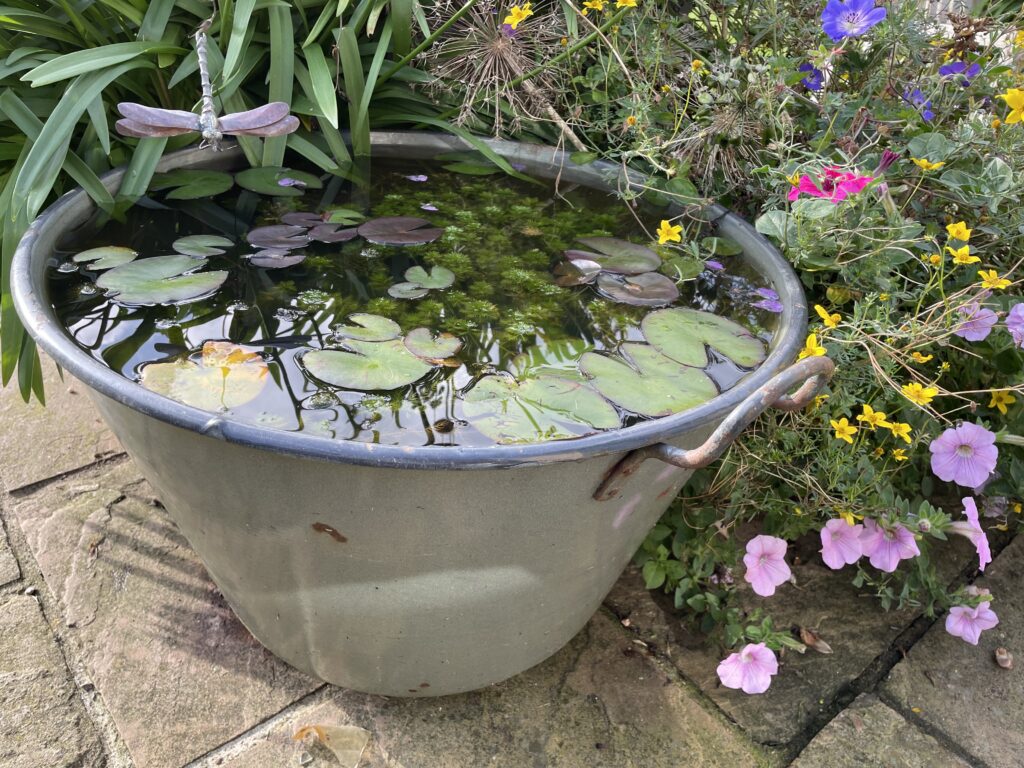You don’t need a nature reserve on your doorstep to make a difference. Here are our top tips for attracting even more wildlife to your gardens and community greenspaces.
Things to consider…
- Focus on what wildlife needs. When it comes to helping wildlife, it’s useful to think about what nature needs. Most features of any habitat fall into one of three categories: food, water or shelter. Remember that some features can help meet more than one need!
- Food – All animals need to eat and there are plenty of ways to provide a source of food where you live. From nectar rich flowers for pollinators to feeders for birds.
- Water – Water is another essential for wildlife. Ponds and bird baths are a great way of including water in your garden and can be adapted to fit most spaces.
- Shelter – Most of our garden visitors like somewhere to hide away. Bird boxes and bug hotels are just a few options. Natural shelter can also be useful. Features like hedges, log piles and dense plants are all good options.
- Use vertical spaces. If you have walls or fences surrounding your garden, you can make the most of them in a few different ways.
- Climbing plants are great for creating shelter and food. Plants like ivy and honeysuckle create lots of little spaces for insects to hide. Ivy grows berries which are great for birds. Honeysuckle grows nectar rich flowers which will attract pollinators.
- You can also attach planters to walls and fences. There are lots of different shapes and sizes of planters available to buy or you can make your own. With a bit of work, old pallets make great multi-levelled planters for smaller plants.
- Planters can help to green the grey. If you need to add some greenery but can’t plant directly in the ground, planters are the ideal solution. You can use individual pots for smaller plants or larger planters for bigger areas. A stack of a few old tyres makes a good planter that doesn’t have any corners or hard edges which can be useful for playgrounds.
- Connect the dots! When you are looking at your garden, remember to think about how each feature links to the others. Patches of long grass can help join features and create natural corridors. For areas without any grass, consider putting the natural features close together so wildlife doesn’t have to travel too far in the open.
- Use some natural pest control. In smaller areas, chemicals can be devastating and harm all wildlife. Try to avoid using chemicals as much as possible. If you have pest problems try using some natural pest control. Ladybirds, lacewings and hoverflies all eat pesky aphids. Frogs, toads, blackbirds and hedgehogs will snack on sails and slugs.
- Make the most of rain. Water butts are a great way of catching rain water which can be used to water plants or top up ponds. If you find you get boggy areas when it rains, try some plants that like damp conditions. Purple loosestrife, meadowsweet and primroses all like a range of moist conditions. Trees like alder and willow also work well in bigger areas.
Useful links


- The Wildlife Trusts have an overview of wildlife gardening. It includes links to a range of activities that can help wildlife in your garden. When you are gardening for wildlife, it’s important to avoid using chemicals. Pesticides and weed killers can harm and kill wildlife indiscriminately. The Wildlife Trusts have a useful guide on how to go organic. The guide includes solutions for some problems that are often tackled with chemicals.
- The Wildfowl and Wetland Trust (WWT) have a great guide on how to make a rain garden. Rain gardens are a brilliant way of dealing with long periods of dry weather. They are beneficial to people and wildlife and make the most of rainwater. The WWT also has a handy guide on making a mini drainpipe wetland.
- The RHS have lots of helpful resources. There are lots aimed at schools and teachers which can also be useful for community projects. This one has some useful tips on creating a wildlife garden in dry conditions.
- Seed bombs are great fun to make for children and adults! They are also a good way of getting some wildflower seeds into an area. There is a handy guide to making them on the Scottish Wildlife Trust website.
